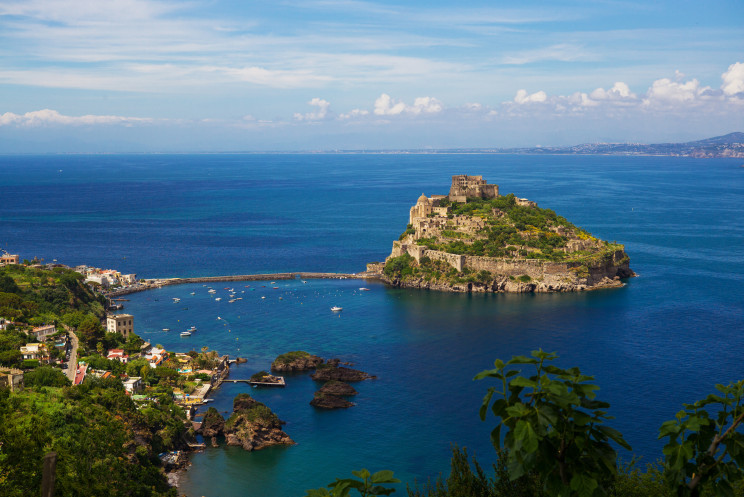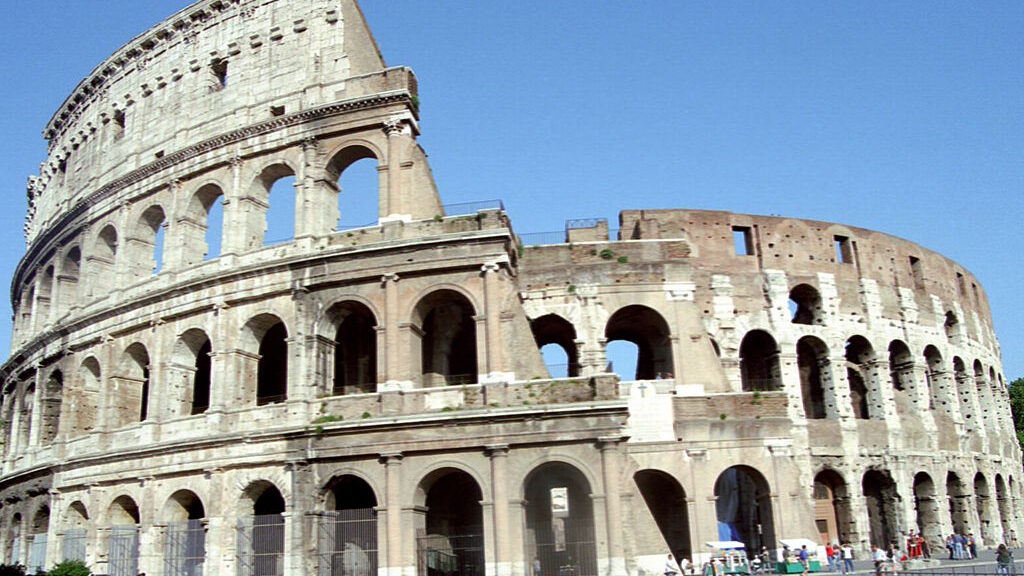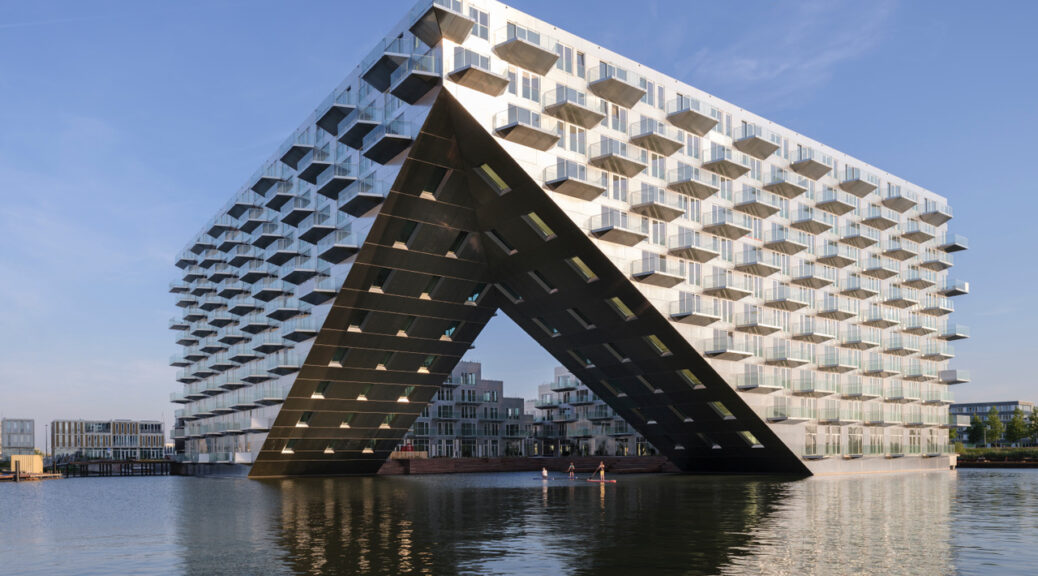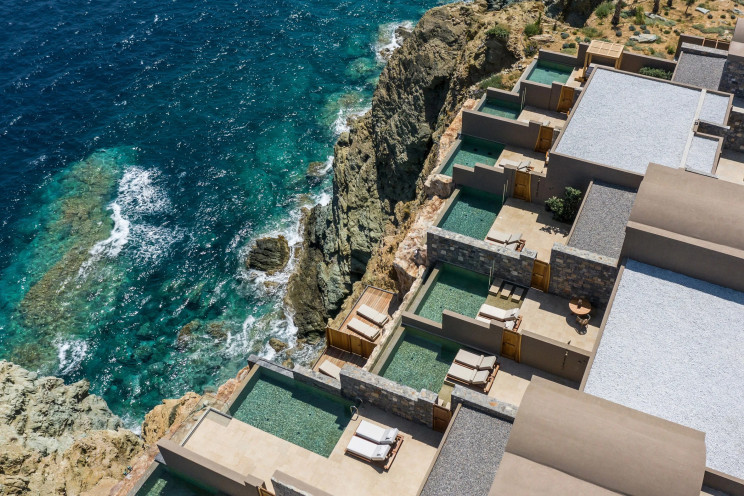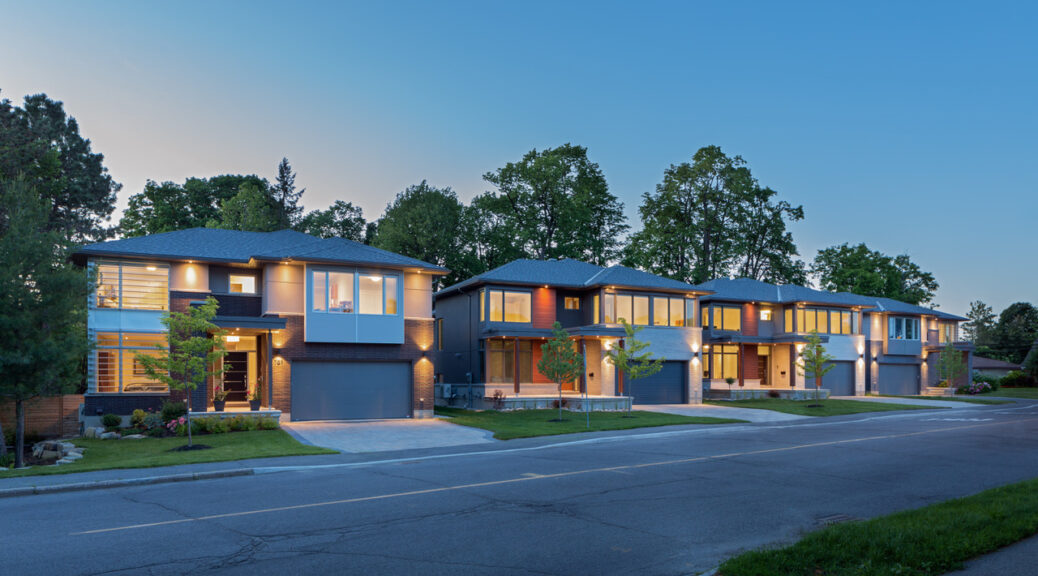All posts by Giulio
Quantum Passivhaus adheres to promise of quality sustainable housing at a reasonable cost
Not only does Quantum Passivhaus offer prefab-certified international passive house systems, but the Minden company is exceedingly proud of its quality control, value and sustainable approach.
And the world is taking notice.
Quantum Passivhaus (QP) has four building components certified with the Passive House Institute (PHI), the only internationally-recognized, performance-based energy standard in construction, plus six more in development. No other Canadian company has reached that certification.
“Sustainability is in everything we do,” says Deborah Byrne, QP’s Vice-President of Operations & Innovations. “PHI is acknowledged as having the most rigorous building standard in the world; we approach a build with the best-in-the-market prefab wall systems.”
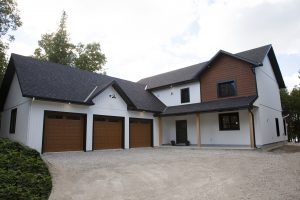
Notably, QP was the first to offer a cold climate wall and has begun the Arctic certification process in support of Indigenous housing in the north.
“Sustainability isn’t just about energy and carbon,” Byrne says. “True sustainability addresses one’s ability to flourish, grow and give back.”
She says that a QP build allows people to live healthily, comfortably, in an energy-efficient durable home, but also has the ability to shelter in times of blackouts or climate crisis. QP homes and buildings are resilient and robust to changes in temperature and, as such, can keep people safe for days in the cold even when there is no power. Moreover, QP homes can be fully electric, affordably.
The QP approach is showcased on many levels with a project at Lorne Beach near Kincardine, Ontario, where multiple unique features are in place that could not be duplicated by quality trades locally.
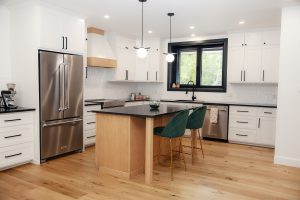
Abby Xerri, President & General Manager at QP, says that project is a perfect example of prefab rapid housing as smart solution, especially through challenging times.
“Not only did the project stay within three per cent of its budget, but its construction was completed in under 13 months with only two days required for superstructure assembly,” Xerri says.
He pointed out that the homeowner had friends in the building industry and they were much more expensive than the cost from QP.
“They (friends) confirmed to them that they would not attempt to construct a home on their behalf with such aggressive energy targets,” Xerri says.
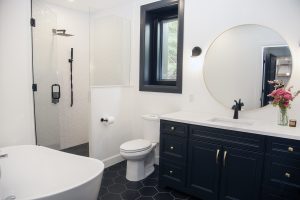
“Their resources were also extremely limited to the experience required to provide other components for cold climate-certified passive house windows and energy-recovery ventilation (ERV). QP’s processes and passive house prefab ‘kept-simple’ approach allowed the project to experience predictable logistical costs through challenging pandemic times.”
QP strictly followed all health and government protocols, for example, organizing safe site activity/access with clients, suppliers or sub trades.
“We managed material deliveries, handling and critical tool/station sharing,” Xerri explains. “We took the necessary measures to work with our sub trades and forecasting of material availability and predictable market pricing.
“We addressed, with the homeowner, the opportunity to re-evaluate or strategize must-haves or appropriate compromises in order manage budget expectations. QP even absorbed certain costs to try to provide an exceptional product and experience for the homeowners.
At the Lorne Beach project, Xerri says all major components were engineered and met all PHI-certified component requirements.
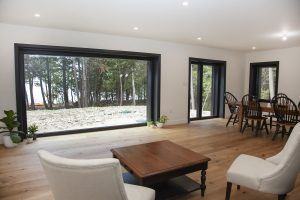
“That passive house prefab build showcased some unique design and living space areas,” he says, “such as an over-garage rec room, and access to the upper level of the main home. The budget included many component-allowance upgrades such as engineered hardwood flooring, tiled bathrooms and kitchen surrounds, custom-built kitchen, solid custom staircase and railings, as well as exterior finish upgrades.”
Xerri says QP is committed to taking part in pilot projects with PHI as part of their development of the standard, science and components.
“We want to be able to offer innovative climate secure solutions to all our clients – homeowners, builders or developers,” says Byrne. “Having simple affordable approaches to climate change is very important to us. Everyone should have access to resilient housing/buildings.
“We continue to work on making sure our product is of the highest quality, while keeping our costs of certified wall panel components down. While other building materials continue to creep up, we’ve managed to remain affordable.”
Xerri says that QP has been making strides to be an industry leader.
“Our focus on providing solutions to many construction challenges using a prefab system is what makes us stand out from the rest.”
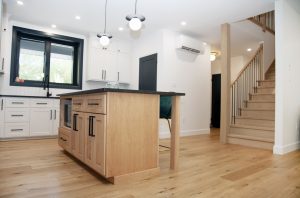
He says that in addition to its world-first cold climate sustainable PHI-certified panels, QP will soon have the first certified Arctic panels and structures.
“Also, QP will soon be manufacturing its own PH window line in partnership with a world-renowned passive house window manufacturer. These windows will not only provide our projects with great value, but the open market stands to benefit, as well, with a homegrown solution suitable for all of climates in Canada.”
Web / quantumpassivhaus.com
Coulter Dawe continues streak as premier custom/design firm in southern Georgian Bay
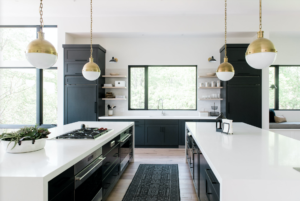
There’s something to be said about a custom home builder that stands the test of time.
In many ways, Coulter Dawe and Associates can attest to that.
The premier custom design/build firm in southern Georgian Bay has been in business for more than 50 years, and that, alone, says a lot. That longevity, however, is merely the tip of the iceberg.
“We have been in business since 1968,” says company president Patrick B. Coulter, “focusing on high-end custom homes. We have built more homes in southern Georgian Bay than any other builder and are considered the premier custom home builder in the region.”
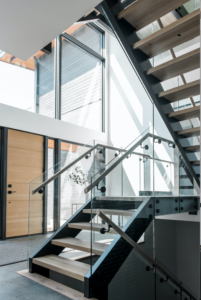
Dawe joined the firm 15 years ago and worked his way through the ranks to his current position of vice-president and principal. He now leads the firm. His in-house projects represent the ultimate in quality and elegance.
Offering full client consultation, from land purchase to occupancy, the company’s management team has been together for 30 years and is fully qualified to assist clients all the way to the final finishes. They have been exceeding customers’ expectations and take pride in getting credit for building projects that will be remembered for generations.
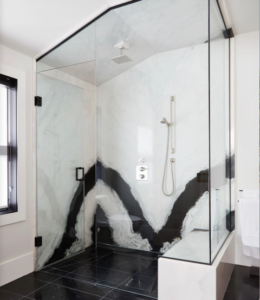
Coulter Dawe believes that choosing the right builder should not be based on a sales pitch; the selection should be done by looking at a firm’s long-standing reputation of guiding clients through the architectural and building process, followed up by delivering what is promised.
“We have a tremendously capable team of staff, experts and associates,” says Coulter. “Distinct by the depth of our experience, the core management team has vast experience at unique site locations and difficult build sites.
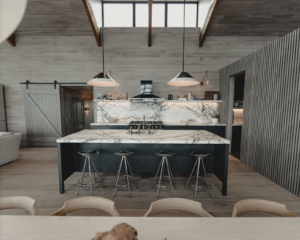
“Our firm is always client-first. We are always respectful of schedule and budget and will not authorize additional spending without client authorization. Every past client would refer us to friends and relatives.”
Currently, when discussing a build with clients, Coulter says many are interested in knowing more about wind and solar power.
“They are all seeking high quality systems, with greater air tightness, higher insulation levels, efficient lighting systems, high-efficient boilers with multiple air handlers, with radiant floor heat considerations.
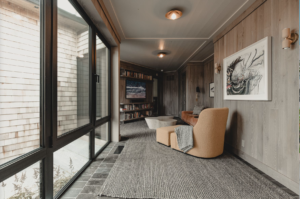
“We have done a number of solar and wind surveys for clients. Our clients generally have elected to go with high-efficiency conventional systems, including ground source options.”
Coulter says the firm has participated in all educational and energy management projects to develop a company attitude towards energy responsibility at all levels of their work.
“We are very focused on perfection at all levels of construction,” says Coulter, whose role into the future will be as senior advisor to Dawe and the team. “We practise a green approach in every one of our projects – it’s not an isolated part of our work. Overall, we produce top-quality projects for our country’s most elite clients.
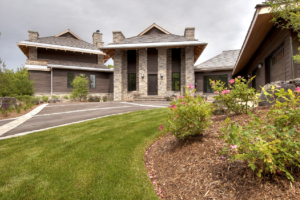
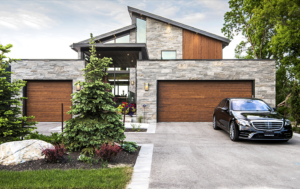
He says Coulter Dawe has an established team of design and system experts who coordinate the performance of a building to ensure the best possible energy performance within the limits created by the building design.
“We are proud to be recognized as the premier custom home builder in southern Georgian Bay,” adds Coulter. “We have studied energy management to guarantee we are ready and aware of the options every client will face and ensure they are guided to wise choices.
“We feel that the choices that are made today in housing must be considered prudent for the next 50 years.”
Web / coulterdawe.com
Sustaining a vision
Onwards and upwards for the Strashin Family’s 501 Alliance project
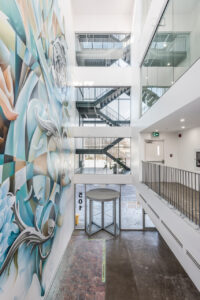
His mantra has been tweaked ever so slightly over the years, but Elliot Strashin’s ultimate goals and aspirations make even more sense today than ever before.
Nowhere is that more evident than in the ongoing progress at 501 Alliance, the Toronto project managed by Strashin Developments, which is undergoing continuous renovation and targeting LEED platinum certification.
“I continue to stand by my belief that the greenest building is the one that already exists,” says Strashin, President of Strashin Developments. “What I find even more true today than ever before, however, is that for sustainability or green technology to gain any traction, it must also make financial sense. Otherwise, people will rationalize that they can’t adopt it right now and nothing will happen.”
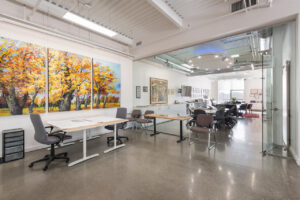
Changing with the times, on any level, means adapting and refining the status quo, something Strashin Developments has done continually … with stellar results.
“Since we started out with 501 Alliance back in 2012, greenhouse gas emissions have only gotten worse,” he says. “Now we face rising interest rates and a possible recession. And Covid has certainly changed the nature of work in the office”.
“But these facts of life only highlight our goals of sustainable, green buildings which reduce carbon emissions and make financial sense. I save money with the changes I have adopted, as well as reduce carbon emissions.”
This project, through its wholly-owned subsidiary 501 Alliance Investments Inc., is taking place at the former Cooper Canada sporting goods factory, near Weston Road and Black Creek. The original building was built in two stages, a one-storey section in 1965 and a four-storey section with full underground parking in 1975.
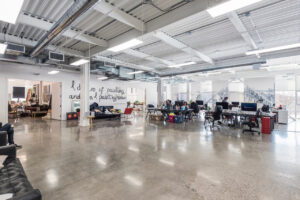
The building is geographically located in the heart of the city, with access to the St. Clair dedicated streetcar, the Eglinton LRT, the Smart Track, GO Transit, plus buses and major highways near Weston Road and Black Creek.
The Strashin project at the 380,000-square-foot facility involves gutting and renovating throughout. It is 2/3 renovated and tenanted to date but is expected to be finished within three years, Strashin says.
Some of the changes included in the renovation include:
- 20-year high SRI reflective roof;
- 298 KW solar farm;
- Insulated roof and walls;
- Storm water harvesting;
- Geothermal HVAC throughout;
- High efficiency plumbing fixtures;
- High efficiency LED lighting and controls;
- Geothermal-heated sidewalks and parking lots;
- Parking for bicycles and electric cars;
- And fibre-optic connectivity.
How is the project taking aim at LEED platinum certification? Strashin says there are a number of initiatives, including stormwater harvesting, geothermal HVAC, passive heating and cooling of the make-up air, high-efficiency LED lighting and insulated roofing and walls.
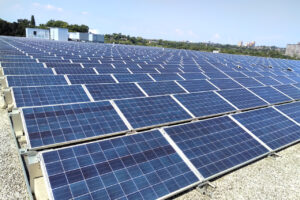
The 298KW solar farm is part of the feed-in tariff (FIT) program undertaken by the previous Liberal provincial government in Ontario.
“The other additions we include make a significant difference, yet they don’t cost much more than a regular renovation,” Strashin explains.
As with any project, occasionally developers have to deal with unforeseen stumbling blocks. In the case of 501 Alliance, Strashin says they were confronted with the fact that the site is located on a floodplain, and work has been affected by three separate once-in-a-hundred-year floods. They persevered, however, flood-proofed the building and continue to follow a sustainable path, despite the obstacles.
With excellent support from like-minded sustainability experts, Strashin has evolved and forged ahead. For example, one of the existing 501 Alliance tenants, Dennis Campbell, of Polar Bear Water Source Heat Pumps Mfg. Inc., interested Strashin with his geothermal technology ideas, so much so that he incorporated geothermal into the building.
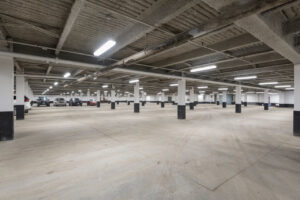
“Geothermal HVAC, with heat pumps operating off ground or lake loops, make the most sense in reducing greenhouse emissions for buildings,” says Strashin, who has now partnered with Dennis and Roman Dychka in Green Systems Group Inc., the successor of Polar Bear. The new company has about 6 projects on the go including an apartment building, a school and some smaller residential and commercial installations
“It’s true that there is incredible demand for geothermal today, what we refer to as ground-source heat pumps. Actually, what other viable choices are there? Ground-source heat pumps work anywhere, no matter the conditions or weather. Compare that to air-source heat pumps that really don’t work well in extreme temperatures.
“Sure, there are drilling costs up front, but depending on your source of heating and AC the payback can be as little as seven years, which is the case for 501.”
At the end of the day, Strashin firmly believes that no matter what materials you use, no matter how carbon neutral you attempt to be, you can never surpass the savings in carbon emissions generated by re-using and repurposing an existing building such as 501 Alliance.
“Again, I target my construction projects to be green because it makes economic sense,” says Strashin. “Green technologies and sustainable development will only become mainstream if it also makes economic sense. Everything we do is carefully engineered by our consultants and researched beforehand, to confirm the savings.”
AMEXON BREAKS NEW SUSTAINABILITY GROUND AT THE RESIDENCES AT CENTRAL PARK
Their master-planned, mixed-use community is the first in Canada to include EV charging stations in all parking areas
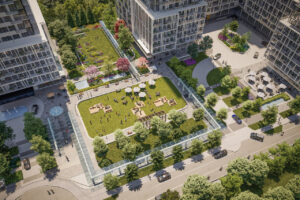
Taking the concept of sustainability to a new level, Amexon Development Corporation’s has launched Central Park, a master-planned, mixed-use condominium community in Toronto’s Bayview village neighbourhood.
Central Park will be constructed to Amexon’s unique Green Development Standard™ incorporating industry-leading green features. It is the first large-scale project of its kind in Canada to include EV charging stations in its over 1,500 parking areas.
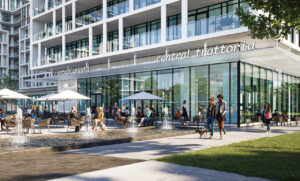
As a member of the Green Building Council, Amexon develops innovative green solutions that conserve natural resources, respect the environment and support viable, healthy communities – now, and in the future. With environmental, social and economic sustainability in mind, Amexon’s Green Development Standard™ incorporates environmentally responsible design and building practices, reduces environmental impact and fosters a clean and energy-efficient lifestyle.
Amexon’s Executive Sales Manager Jason Shiff said, “We believe that reducing the carbon footprint in all our residential and commercial communities is the right thing to do. In our buildings, we strive to incorporate industry-leading sustainable green features and initiatives such as green roofs, rooftop solar panels, high-performance thermal building envelopes, next-generation mechanical systems, low water- and electrical-use systems and appliances. Central Park is testimony to that commitment.”
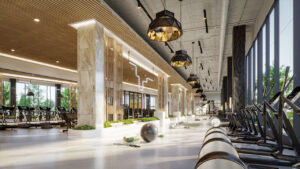
The 12-acre community, adjacent to the East Don Parkland’s forested ravine and close to numerous urban conveniences, and offers the opportunity to live, work and play in a prime Toronto location. The Leslie subway station and the relocated Oriole GO station are situated within Central Park. In addition to immediate access to public transit, this location is close to Highway 401 and the Don Valley Parkway. Bayview Village Shopping Centre is nearby, with shops and services ranging from restaurants to lifestyle and wellness.
According to Shiff, “This upscale community will be a tranquil oasis in bustling urban surroundings. Outdoor lovers can immerse themselves in nature year-round. The adjacent ravine is part of the Don River Valley parklands, where a network of walking and cycling trails leads all the way downtown. The environmental features are the icing on the lifestyle cake at Central Park.”
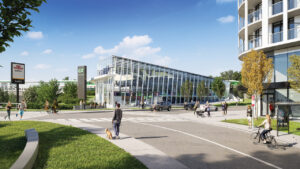
Community amenities include retail space, restaurants, and services, including on-site daycare. At the heart of the property, Central Park Common is a landscaped, 3-acre urban park with bike paths, casual dining venues, fountains, reflecting pools, and year-round programming that will include a farmers’ market and an ice-skating rink.
The exterior for the residential condominium features facades with an organic leaflike design. Among the architectural highlights are 6-foot-deep balconies and views through floor-to-ceiling windows. “We wanted to break away from the conventional,” says CORE Architect’s Deni Poletti, “to express a harmonious coexistence between sparkling glass and nature. It was important to be respectful of the development’s natural setting above the East Don Parkland.”
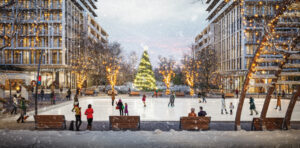
Central Park’s residents will have the use of 55,000 square feet of fitness, wellness, leisure, and social amenity space in The Park Club. It will also include a 5,000-square foot co-working space with smart technology, meeting rooms, hot desks, and a business centre.
The community will eventually encompass over 1,500 suites in one- to three-bedroom + den layouts, in sizes from 439 to 1,200 square feet. Features and finishes include 9-foot-high European-inspired kitchen cabinetry.
The most beautiful island in the world 2022? It’s Italian and this is it
The most beautiful island in the world 2022? According to the well-known American magazine Travel+Leisure, it’s Ischia. In the annual ranking of the most beautiful islands in the world 2022, the small pearl of Italy takes the first place. Ischia was considered the most beautiful island in the world 2022 by Travel+Leisure readers with a score of 94.61.
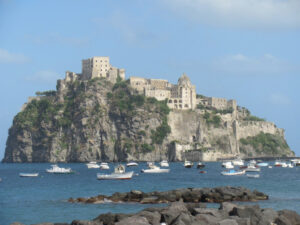
Ischia has beaten other beautiful islands in the ranking. But let’s see what are the pearls in the list of the top ten most beautiful islands in the world 2022 compiled by Travel+Leisure:
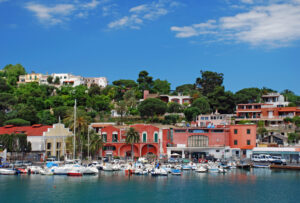
Ischia
Maldives
Bali
Milos
Fiji Islands
Galapagos Islands
Phuket
Dominica
Boracay
Cape Breton Island
What rewarded this pearl of the Gulf of Naples were the picturesque views, the hot springs, the pristine beaches and the friendliness of the residents.
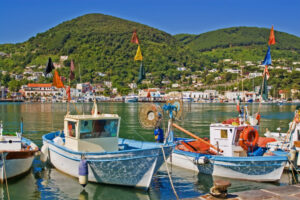
But what are the treasures of Ischia that have made it, for the readers of the prestigious travel magazine, the most beautiful island in the world?
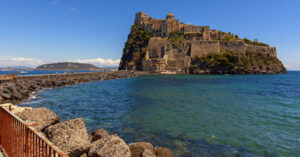
First of all, we must remember that Ischia is a volcanic island. A fact that has given rise not only to some of its glittering black sand beaches, but also to the numerous thermal springs, to the point that thermal bath establishments are its hallmark.
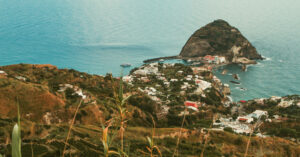
But Ischia is also perfect for those who dream of a relaxing wellness vacation. It is no coincidence that it is possible to bathe in crystal clear waters such as those of the bay of Sorgeto or that of San Montano.
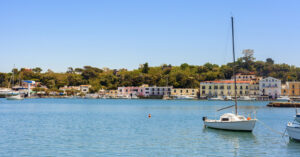
Ischia is also an island rich in culture. It is no coincidence that the most important monument is the Aragon Castle, which stands on a small island connected by a bridge to the rest of the island.
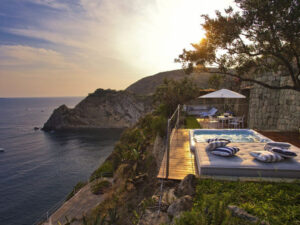
The first construction of the castle dates back to 474 BC by Hieron of Syracuse, but it was not until 1441 with Alfonso V of Aragon when it reached its current physiognomy. Inspired by the Maschio Angioino in Naples, it is now privately owned, but accessible to the public through paid visits.
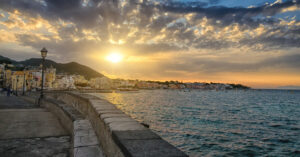
At the southern tip of the island is Borgo Sant’Angelo, a typical fishing village. The characteristic colorful houses are built against the mountain that rises above it. Closed to cars, the village can only be visited on foot, starting from the typical small square. From here starts the typical dirt road that leads to the famous Fumarole. The island’s subsoil gives off heat here, which makes the beach particularly warm.
Rome’s Colosseum has no price tag, but Deloitte estimates it is worth $79 billion.
The consulting firm Deloitte has made an estimate of the tangible and intangible value of one of the seven wonders of the modern world: the Colosseum in Rome. The Flavian Amphitheater contributes about $1.4 billion a year to Italy’s GDP, but its mere existence and all that it brings to the city and the country is estimated at $79 billion, about 77 billion euros at current exchange rates.
Calculating its economic contribution is relatively easy, between the direct cost of admission fees and the impact of visitors and tourists on other businesses around the historic center of the Eternal City. But its value is much more than that, and not only for Italians, nor for all the visitors who visit the forum every year.
The Deloitte study evaluated a survey asking whether they would be willing to pay for a good (or service) even if they have no direct use for it, and do not plan to use it in the future. According to the analysis, each Roman citizen would be willing to pay an average of €90, while in the rest of Italy, the figure would remain at €57.
The Colosseum in Rome underwent a deep restoration of about 25 million euros between 2011 and 2016, largely financed by the Italian group Tod’s. With the pandemic, visits have dropped but in 2019, a precovid year, the monument welcomed some 7 million tourists.
Sluishuis Residential Building / Barcode Architects + BIG
A new icon and entrance for Amsterdam IJburg
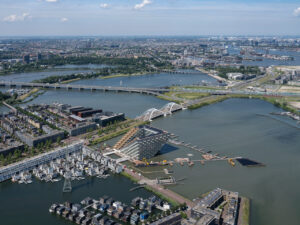
After four years of construction, Sluishuis has been completed. Amsterdam IJburg now has a new, architecturally iconic landmark. The building forms a bridge between IJburg and the city center. With 442 different types of owner-occupied and rental homes, a public green roof garden with a rooftop walkway, bird and recreational islands, jetties for boats, and catering facilities, Sluishuis is a place for everyone.
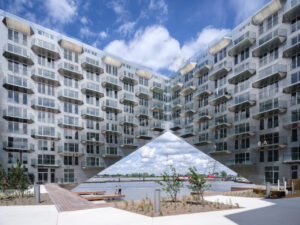
Leading architecture
Sluishuis offers a modern and sustainable way of living on and around water. It is a remarkable building with a unique volume that seems to float on the water thanks to the double cantilever. The cantilevers come together in a high corner that forms a large gateway from the IJ to the inner harbor of the building. On the other side, the building is complemented with stairs leading towards its rooftop and green, welcoming terraces: an inviting gesture towards the neighborhood of IJburg.
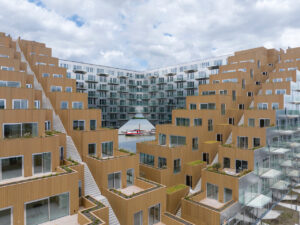
Bjarke Ingels, Founding Partner at BIG, says: “Having spent my formative years as an architect in The Netherlands at the end of the 20th century, it feels like a homecoming to now get to contribute to the architecture of the city that I have loved and admired for so long.” Dirk Peters, Founding Partner at Barcode Architects adds: “With iconic architecture, as well as new housing typologies, high-quality outdoor spaces, and breathtaking views of the IJmeer, Sluishuis is a new landmark for IJburg as well as Amsterdam.”
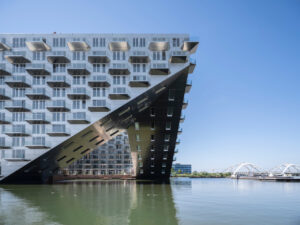
A new living experience on the water
Sluishuis consists of 442 energy-neutral owner-occupied and rental apartments and an offer featuring houseboat lots, jetties for pleasure crafts, hospitality facilities, commercial spaces, and a fully integrated water landscape with islands for recreation, water sports, fauna and flora, and even power generation. The project is largely publicly accessible. Residents and visitors can linger in the inner harbor, enjoy the promenade with stunning rooftop views, and benefit from the jetties and islands, spot water birds or admire the historic houseboats.
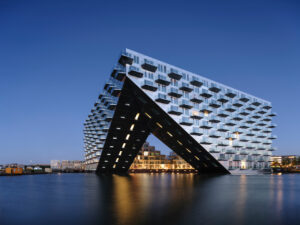
Sluishuis offers different apartment types and was designed for a variety of target groups, income levels, and age categories. In addition to compact city studios and water sports apartments, Sluishuis features duplex penthouses with views on both the inner harbor and the IJ-lake. The stepped part of the building comprises premium apartments with luxurious wooden sun-oriented roof terraces with views over IJburg. The apartments at the bottom of the cantilever with splendid views over the IJ-lake are particularly remarkable.
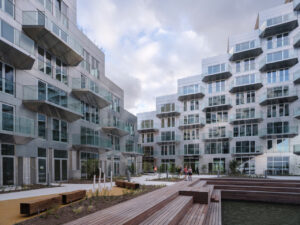
Integral sustainability
The sustainability of Sluishuis is an integral part of the project. With an energy performance coefficient (EPC) of 0.00, the building generates more energy than it consumes. The building’s heating requirements are minimized by combining high-performance insulation techniques, triple glazing, and heat recovery on the ventilation systems and wastewater. Energy consumption is further reduced by a heat and cold storage (CHS) system in the ground for heat and cooling in combination with a connection to the district heating system for peak times.
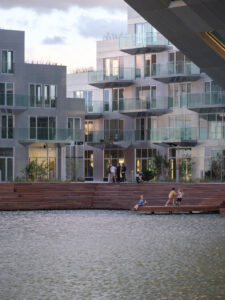
The remaining energy consumption for heating, heat pumps, ventilation, and LED lighting is fully compensated by approximately 2,200 m² of solar panels, to which an entire floating island adjacent to the project is dedicated. The development team of Sluishuis paid particular attention to green space and water collection. The front sides and the inner harbor of the building feature gardens with local plant species. The greenery runs across the roof terraces up into integrated planters, creating a pleasant green atmosphere.
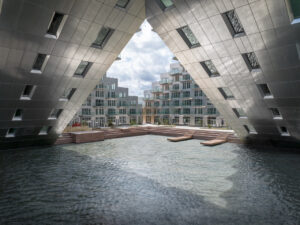
Reinforcing social cohesion
In addition to the building’s sustainable features, Sluishuis aims to stimulate and strengthen the social connections between residents and visitors. The staggered balconies encourage relationships and exchanges. The public walkway towards the rooftop, but also the children’s playground in the inner harbor, the landscape with jetties, and the wooden roof terraces promote spontaneous encounters.
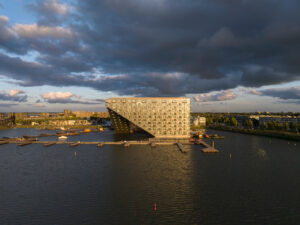
Hans Meurs, CEO VORM: “If we were to design all the Netherlands like Sluishuis, we would no longer have an energy problem and loneliness would be almost impossible. A successful project in every sense of the word. We all worked with passion on this project. That makes me proud.”
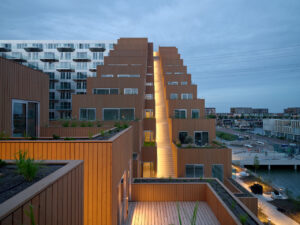
Natural materials
The building materials contrast and connect with their environment. Natural materials were chosen for their material palette, which will give the building a rich and natural look over the years. The abstract, untreated aluminum of the facade reflects the water and gives the volume a different look at any time of day. In contrast, the stepped roof terraces and the jetties landscape are made of wood which gives a tactile appearance. The building’s façade is circular.
Photographs :Ossip van Duivenbode
A luxury hotel on a cliff in Crete with rooms carved out of the rock
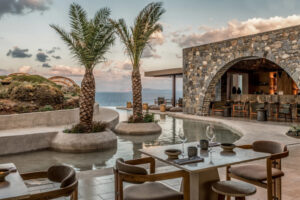
The Arco Suites complex has 49 suites and villas in buildings constructed of stone and wood. Some of the rooms are carved into the cliffs of Crete’s Mononaftis Bay. Each of the suites at this Greek hotel has its own private saltwater pool overlooking the Aegean Sea.
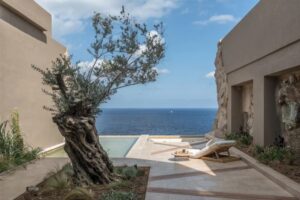
Some of the suites were carved directly into the cliff, with parts of the rock exposed around the pool terraces and throughout the interior to preserve the feeling of a cave. The stone walls also help maintain a comfortable temperature throughout the year, reducing the need for heating and air conditioning.
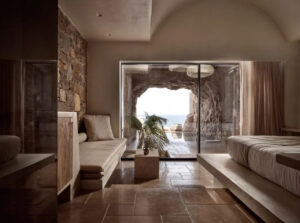
The hotel’s common areas are furnished with custom-made marble, natural fabrics and copper and wood details. It features several outdoor lagoons and an indoor spa, with oval design and smooth stone, which contrast with the roughly carved walls and wooden doors.
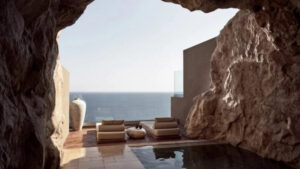
In addition, this wellness-focused establishment houses a Byzantine hammam, a Finnish sauna, two treatment rooms, an outdoor pool and a heated pool.
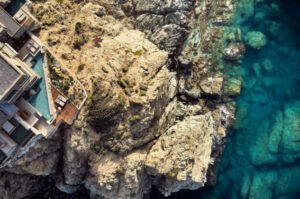
The RND Solution
Ottawa’s premier green builder forges ahead during pandemic with net-zero homes
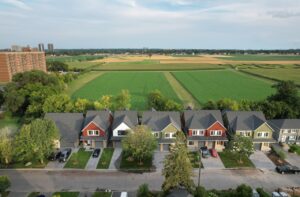
As incredible as it sounds, RND Construction overcame one obstacle after another to build nine net-zero-ready homes while dealing with Covid-19 organizational realities.
The result is Farmside Green, the brainchild of RND president Roy Nandram, who nurtured the Ottawa project from the get-go.
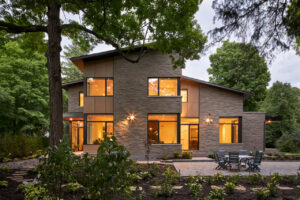
“The challenges during Covid included a steep increase in building material costs, especially in lumber,” says Nandram, whose company has been building green for 30 years and is a regular award winner at local, provincial and national levels. “But there were also long lead times for delivery of finishing products and securing trades. And there were also challenges building homes during the winter on a tight site.”
Designed by Hobin Architecture, the development was planned for R-2000 standards, which is 50 per cent more energy efficient than conventional builds. RND decided to upgrade these homes to net-zero during the construction process. Hobin looked to farmhouse design concepts as inspiration for the homes’ exteriors, showcasing prominent gables, then combined that with bright, modern-themed interiors.
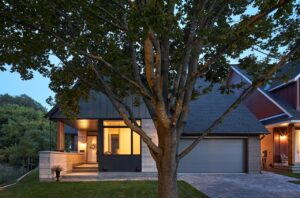
Farmside Green consists of three pairs of semi-detached and three single-detached net-zero homes. The development backs onto Ottawa’s historic 427-hectare Central Experimental Farm and features smart floorplans, tasteful style and an eco-friendly base that positions it as a futuristic energy-efficient standard incorporating resilient construction techniques.
With square-footage ranges from about 1,800 to 2,450, the homes were designed to complement the nearby area and scenery. Nandram named the various homes after traditional Canadian trees, including Maple, Hemlock, Walnut and Birch. The development features a bike path that leads to the adjoining farmland.
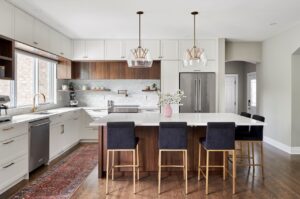
Also close to the Civic campus of The Ottawa Hospital, Nandram points out that Farmside Green is an “amazing” location.
“The Central Experimental Farm was the clincher and, with no backyard neighbours, the project is like a little island,” he says.
The overall design utilizes a forceful colour palette so each house is slightly different, to eliminate the sameness so often evident in standard developments. With Farmside Green there is also eco-conscious construction that includes upgraded insulation, triple-glazed windows and high-performance heating systems.
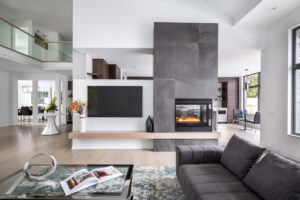
Besides exceptional backyards and design, Farmside Green is close to the Queensway, which provides easy access to the events, restaurants and shops downtown. Also close by is Preston Street, known as home to the vibrant Little Italy community. Again, a bike path extends from the development, reaching across Central Experimental Farm and ensuring an accessible link to the city network.
RND Construction builds these kinds of net-zero-ready homes to be at least 50 per cent more energy-efficient than standard builds, with Nandram’s green passion evident every step of the way.
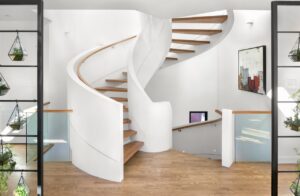
“I am very concerned for the environment,” he says. “Plus homeowners know they are getting a thermally comfortable home and take pride in the fact they are helping reduce greenhouse gas emissions. As more and more customers request net-zero-ready homes, we will continue to build them when the opportunities present themselves.”
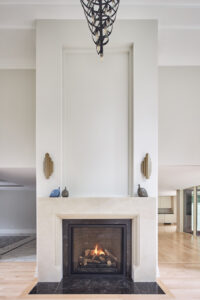
While working on Farmside Green, RND built Vista Green, a two-home development on a corner lot at Alta Vista Drive and Mountbatten Avenue in Ottawa. The lot was severed, which promoted efficient land use and compact form. Both homes have also been certified as R-2000 and net-zero. One model is called The Veranda, and has a large front porch. The other, The Terrace, has a rooftop terrace and elevator. Nandram confirmed that his company has another five net-zero-ready homes under construction.
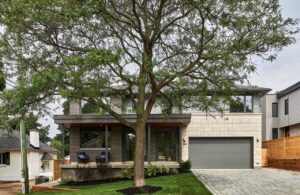
RND subscribes to a philosophy that promotes ‘green’ as a method of constructing homes and buildings which utilizes environmentally-friendly techniques while creating a sustainable and energy-efficient final product. Nandram says the advantages are many, including long-term savings and numerous health benefits for the homeowners. Perhaps most importantly, he points out, it gives homeowners an active role in protecting against climate changes and preserving natural resources for future generations.
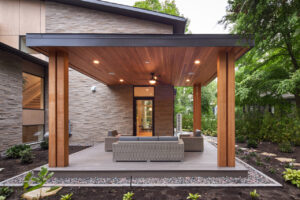
To that end, RND focuses on incorporating design, comfort and operational efficiency into each project, always with an eye on a net-zero possibility. The combination of all three aspects helps to create an ideal living environment that is sustainable, as well as stylish and cost-effective.
Web / rndconstruction.ca
Net-zero homes were once only seen in custom homes, but committed and passionate builders such as RND Construction now offer net-zero and net-zero-ready production of homes and communities. Energy efficient homes are becoming more desirable to many Canadians who are looking for superior quality, greater comfort, and who want to be environmentally responsible. And net-zero communities are helping reach Canada’s emission reduction targets. (Note: A net-zero home produces the same amount of energy that it consumes annually through renewable energy resources).












